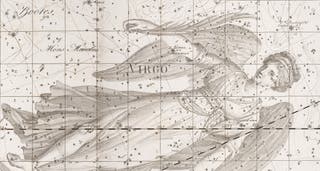Littrow, Joseph J. von. Atlas des gestirnten Himmels. Stuttgart, 1839.
Littrow's Atlas of the Starry Heavens was compiled for the use of other astronomers, rather than for the viewing public. The constellation figures have been reduced to a faint outline, although the star symbols are very dark and prominent. Only Bayer letters are used for nomenclature. Being German, von Littrow did tend to follow the Bode rather than the Flamsteed tradition, and all of Bode's constellations, both the ones he invented and the ones he adopted, are included here.
The plate above shows the traditional Canis Major, as well as such Bode innovations as Officina (the printing press) and Felis (the cat), who is at far left, peering down at a Lacaille constellation, Pyxis (the compass). This was the last time the Bode constellations would appear in a professional atlas.

